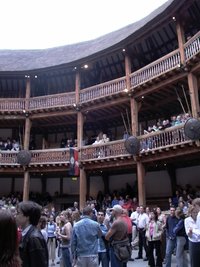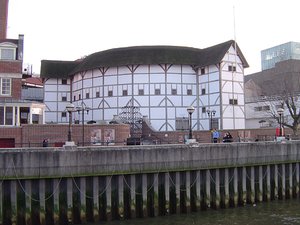Globe Theatre
|
|
This article is about the Globe Theatre of Shakespeare, both the original and its modern reconstruction. For other Globe theatres, see Globe Theatre (disambiguation).
The Globe Theatre normally refers to one of three theatres in London associated with William Shakespeare.
- The original Globe Theatre, built in 1598 by the playing company to which William Shakespeare belonged, and destroyed by fire in 1613.
- The rebuilt Globe Theatre, built in 1614, closed in 1642, and demolished in 1644.
- A modern reconstruction of the original Globe, named 'Shakespeare's Globe Theatre' and opened in 1997.
| Contents |
The original Globes
The original Globe was an Elizabethan theatre built in 1598 in London's Bankside district, one of several major theatres in the area, the others being the Swan, the Rose, the Fortune and the Hope. The Globe was owned by the actor Richard Burbage and his brother Cuthbert, and was the principal playhouse of the Queen's Men (later the King's Men), the playing company to which Shakespeare belonged. Most of Shakespeare's post-1598 plays were originally staged at the Globe.
The first Globe blew to the ground in 1613, apparently by wind from a tornado during a performance of Henry VIII that ignited the thatched roof of the gallery. It was rebuilt immediately, this time with a tiled roof, and reopened in July of the following year.
Like all the other theatres, it was closed down by the Puritans in 1642, and was destroyed in 1644 to make room for tenements. Its exact location remained unknown until remnants of its foundations were discovered in 1989 beneath Anchor Terrace on Southwark Bridge Road. There may be further remains beneath Anchor Terrace, but the eighteenth century terrace is listed and may not be disturbed by archaeologists.
Layout of the Globe
The Globe Theatre's precise shape and size have been pieced together by scholarly inquiry over the last two centuries. The evidence suggests that it was a three-story, 100-foot wide, open-air amphitheater that could house around 3,000 spectators. In one of Shakespeare's plays, Henry V, it is referred to as "this wooden O" and on a woodcut of London, it appears round. On this basis, some assume the building was circular, while others favor an octagonal shape.
At the base of the stage, there was an area called the 'yard' where people (the "groundlings") would stand to watch the performance. Around the yard were three levels of seating, which were more expensive than standing: the first two were called the Twopenny Rooms and the top level was called the Penny Gallery.
A rectangular stage platform thrust out into the middle of the open-air yard. This stage measured roughly 43 feet wide and 28 feet deep. On this stage, there was a trap door for use by performers to enter from beneath the stage; the area beneath the stage was known as the 'cellarage'. There was a second trap door in the back of the stage that was used for the same purpose.
On two sides of the stage were large columns called 'stage posts', supporting a roof over a portion of the stage. This ceiling was called the 'heavens', and was painted with images of the sky. A trapdoor in the heavens enabled performers to 'fly' or descend using some form of rope and harness.
The back wall of the stage consisted of three doors on the first floor and a balcony on the second. The doors entered into the 'tiring house' (backstage area) where the actors dressed and awaited their entrances. The balcony housed the musicians and could also be used for scenes requiring an upper space, such as the balcony scene in Romeo and Juliet. In addition, it could be used as the 'Lord's Room', where higher-paying audience members could pay to get the best view in the house.
The modern Globe
At the instigation of Sam Wanamaker, a new Globe theatre was built according to an Elizabethan plan. It opened in 1997 under the name 'Shakespeare's Globe Theatre' and now stages plays every summer.
The new theatre is 200 yards from the original site, and was the first thatched roof building permitted in London since the Great Fire of London of 1666.
As in the original, both the stage and the audience are outdoors. Plays are put on during the summer, and in the winter the theatre is used for educational purposes, and tours are available.
Although the reconstruction is carefully researched, the original plan was modified by the addition of sprinklers on the roof, to protect against fire, and the theatre is partly joined onto a modern lobby and visitors centre. In addition, only 1,500 people may be housed during a show, unlike the 3,000 of Shakespeare's time (Elizabethans were smaller and less fussy about their personal space than modern theatregoers).
External link
- Shakespeare's Globe Theatre website (http://www.shakespeares-globe.org/)de:Globe Theatre


